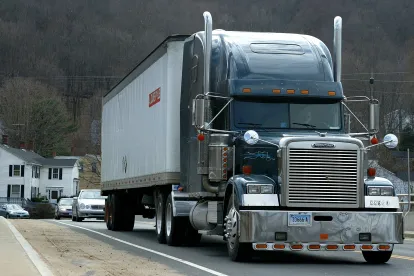Our team at Squire Patton Boggs monitors developments surrounding the heavy-duty vehicle and engine sector. Our last blog post on this topic covered updates on US EPA’s proposed Control of Air Pollution from New Motor Vehicles: Heavy-Duty Engine and Vehicle Standards and California Air Resources Board’s (CARB’s) rulemaking for off-road diesel engine regulations. In this post, we will discuss CARB’s Advanced Clean Trucks Regulation (ACT Regulation), US EPA’s recent waiver approval for the ACT Regulation, US EPA’s recent Phase 3 greenhouse gas (GHG) emissions standards, and expectations for other developments in the sector moving forward.
Background on CARB’s Advanced Clean Truck Regulation
The final regulation order on CARB’s ACT Regulation was published and filed with the Secretary of State on March 15, 2021. As noted in CARB’s fact sheet on the ACT Regulation, the regulation includes zero-emission vehicle (ZEV) sales and reporting requirements for large entities and fleets. The zero-emission truck sale mandate applies to chassis or complete vehicle manufacturers of vehicles with Gross Vehicle Weight Rates (GVWR) > 8500 lbs (Classes 2b-8) who must sell zero-emission trucks at an increasing percentage, including 55% of Class 2b-3 truck sales, 75% of class 4-8 straight truck sales, and 40% of truck tractor sales by 2035. With the company and fleet reporting mandate, large employers such as retailers, manufacturers, brokers, and others must report information about shipments and shuttle services. Additionally, fleet owners with 50 or more trucks must report on existing fleet operations. Notably, California is also finalizing its Advanced Clean Fleets Regulation (ACF Regulation), which is designed to complement the ACT Regulation by encouraging demand for ZEV from companies operating 50 or more affected vehicles (>8500 lbs GVWR) or operating one or more affected vehicle with $50 million or more in gross revenue. The ACF Regulation is discussed in more detail below.
US EPA Waiver Approval
While the Clean Air Act generally preempts state standards on federal regulation of motor vehicle emission standards, Section 209 provides a waiver process for California. US EPA recently considered two CARB waivers. A US EPA press release regarding the recent CARB waivers noted US EPA had “determined it appropriate” to grant “two requests for waivers of preemption regarding four [CARB] regulations related to California’s heavy-duty vehicle and engine emission standards.” US EPA’s approvals were formally published in the Federal Register on April 6.
The ACT waiver includes waivers for two additional regulations: the Zero Emission Airport Shuttle Bus (ZEAS) Regulation and the Zero Emission Powertrain (ZEP) Certification Regulation. The second waiver, for 2018 Heavy-duty Warranty Amendments, allows CARB to tighten the emissions control warranty requirements for 2022 and subsequent model year on-road heavy-duty diesel engines and diesel vehicles with gross vehicle weight ratings exceeding 14,000 pounds powered by such engines. US EPA has also conducted the public comment process for CARB’s heavy-duty Omnibus Low NOx Regulation, but CARB requested additional time before the Agency acts on this waiver amidst industry concerns related to that regulation.
Notably, a legal battle regarding California’s ability to impose more stringent emissions standards than national standards under a CAA waiver is currently pending in the US Court of Appeals for the District of Columbia (No. 22-1081). Filed in May 2022 by the State of Ohio, several other states, industry participants, and trade associations, oral arguments are set for September 2023. Petitioners are challenging the constitutionality of US EPA’s reinstatement of California waivers. A decision upholding Petitioners’ challenge could invalidate many of California’s emissions programs, including ACT. Meanwhile, the April 6 publication of US EPA’s most recent waiver approvals begins a sixty-day litigation window for challenges to these newest waivers.
US EPA’s Phase 3 GHG Emissions Standards
One expectation associated with US EPA’s waiver approval for the ACT Regulation was that the ACT Regulation would impact US EPA’s proposed Phase 3 GHG emissions standards, which had not yet been released when the waiver was approved. On April 12, 2023, US EPA announced its proposed Phase 3 GHG emissions standards for heavy-duty vehicles and, as anticipated, cited the ACT Regulation as support for its projected ZEV adoption rates.
US EPA’s proposed standards will apply to heavy-duty vocational vehicles, including vehicles such as delivery trucks, refuse haulers, public utility trucks, transit, shuttle, and school buses, and to tractors, such as day cabs and sleeper cabs on tractor-trailers. US EPA’s fact sheet explains that the proposed program will revise MY 2027 standards for vocational vehicles and day cab tractors, making them more stringent than the Phase 2 GHG standards, and will also introduce new standards that become progressively more stringent from 2028 to 2032. Additionally, the proposed standards will introduce new requirements for MY 2030 sleeper cab tractors that will increase in stringency through MY 2032. US EPA’s proposed standards do not mandate use of a specific technology to reach these proposed standards.
The following table provides an example of US EPA’s proposed standards, using CI medium heavy vocational vehicles:
|
Model Year |
Urban Subcategory |
Multi-Purpose Subcategory |
Regional Subcategory |
|
2027 |
213 |
190 |
173 |
|
2028 |
209 |
186 |
169 |
|
2029 |
202 |
179 |
162 |
|
2030 |
195 |
172 |
155 |
|
2031 |
188 |
165 |
148 |
|
2032 and later |
176 |
153 |
136 |
CI Medium Heavy Proposed MY 2027 through 2032+ Vocational Vehicle CO2 Emission Standards (grams/ton-mile)
As this table illustrates, the proposed standards become progressively more stringent from 2027 through 2032. Other tables with proposed standards are available in the rule.
Of additional note, US EPA acknowledged that the approach used for developing the proposed Phase 3 GHG standards did not account for ZEV adoption rates as implemented by the ACT Regulation. Because the ACT Regulation waiver was approved just before US EPA announced these proposed standards, US EPA intends for the final rule to consider further how the ACT Regulation waiver may impact the approach it used to set these proposed standards.
US EPA will hold a virtual public hearing on the proposed rule on May 2–3, 2023. Information on registration for that hearing can be found here. Additionally, the proposed rule was formally published in the Federal Register on April 27, 2023, which opens a fifty-day comment period through June 16, 2023.
Upcoming Developments
In addition to watching petitions for review of US EPA’s waiver approvals and comments on US EPA’s newly proposed Phase 3 GHG standards as discussed above, other medium- and heavy-duty truck developments to watch for include:
-
State ACT Regulation Adoption. Now that the ACT Regulation waiver is approved, it is possible that more states will follow CARB’s ACT standards. Section 177 of the Clean Air Act allows other states to adopt California’s standards. According to a website that tracks ACT adoption around the country, six other states have already adopted the ACT Regulation, including Massachusetts, New Jersey, New York, Oregon, Vermont, and Washington. The ACT Regulation is pending in at least three additional states, including Connecticut, Maryland, and Maine. As noted above, US EPA intends to consider state adoption of the ACT Regulation as it prepares to finalize the Phase 3 GHG emissions standards.
-
Future US EPA Waivers and CARB’s ACF Regulation. US EPA will also likely soon act on CARB’s Omnibus Low NOx waiver, and in the future, CARB will also seek a waiver for its ACF Regulation. CARB’s final ACF Regulation is anticipated at the end of April. The ACF fact sheet notes that the ACF Regulation is designed to complement the ACT Regulation and accelerate the market for ZEV trucks, vans, and buses. The proposed final rule would require a 100% medium- and heavy-duty ZEV sales requirement by 2036. This ACF Regulation would apply to fleets performing drayage operations, government agencies, and high priority fleets. Comments on the proposed final ACF Regulation were due on April 7, 2023. Comments received included concerns such as whether there can be available infrastructure to support electrified fleets by the proposed deadlines, whether technology is sufficient to meet the proposed deadlines, and whether there is sufficient ZEV availability to meet the deadlines. Comments on US EPA’s Phase 3 GHG standards will likely include similar concerns regarding available technology and infrastructure.
In summary, there are many imminent changes for the heavy-duty vehicle and engine sector. Our team at SPB will continue to monitor and provide updates on these developments in the future.
Tweet this post Like this post Email this post Share this post on LinkedIn





 />i
/>i
